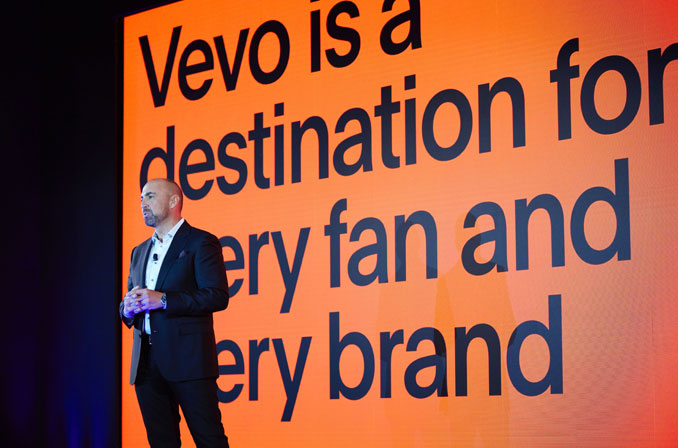Vevo views itself as an important complement to broadcast TV campaigns as advertisers look to extend reach using premium video and increasingly connected TV, especially into the 18-34 demographic. Speaking shortly after the IAB NewFronts earlier this month, Kevin McGurn, President, Sales & Distribution at Vevo, pointed out that “our cross-screen reach is no less than one-third of every country we operate in – and in the U.S. we reach 65 million people on television.” He added: “We offer incremental reach on top of broadcast TV. Our research in the U.S. shows that we have stunning incremental reach even for advertisers who have a large tonnage on television.”
Vevo represents the music labels, and offers a VOD catalogue of 800,000 titles as well as FAST channels, with its content available through multiple platforms including Samsung TV Plus, Roku, Apple, Amazon and also Pay TV platforms like Sky Q. Vevo on YouTube accounts for a large part of the reach for the music-focused programmer. McGurn describes Vevo as a ‘high reach, low frequency’ solution for advertisers, with that characteristic largely a result of how people watch music videos.
“This is what advertisers come to us for: reach extension with moderate frequency,” he declares. “What is interesting about campaigns on Vevo, from advertisers across consumer electronics to film and auto insurance, is that no matter what you buy from us, we deliver the audience, but frequency never reaches above three. That speaks to the diversity of the video offer. For one advertiser, we had to narrow the reach to dial-up the frequency they wanted, but I think it is a better challenge to increase frequency than deal with too much frequency.”
Vevo has rapidly expanded its FAST channel offering and viewers can now find up to 15 of these linear (ad supported) streamed channels on a typical connected TV platform. This is a lean-back, curated experience and because the channels are genre-based (spanning Pop to Hip-Hop, Country and Latino, for example) or decade-based (e.g., ‘80s or ‘90s) advertisers can reach largely different groups of people via each channel. “There is massive incrementality – as much as 95% incrementality,” reveals McGurn, drawing on research that Vevo presented at the IAB NewFronts in New York.
For consumers, FAST is about removing the decisions needed every four minutes on what to watch next, McGurn says. “It is too much work to constantly choose, and with the curated channels you have passive playback and if you don’t like what is on one channel, you can go to another. We can still keep them [the viewer] on the Vevo network. For us, it is also fun. We like being a curator and that is what the music industry expects from us – we are supposed to be promoters of new music and fandom.”
Asked if Vevo would like to be more than an app on Pay TV/MVPD platforms, in the way that direct-to-consumer streamers like Disney and Netflix are being deeply integrated into the home screen content promotions today, McGurn would only say that “we know our content will be popular wherever it sits, but it is not for us to decide how it should be promoted.” He did admit interest in Vevo appearing within broadcaster streaming (BVOD) services, as some broadcasters start to include third-party content. Vevo is not found in any primary BVOD services yet, “but I would see us as a great content addition in that environment.”
Another part of the Vevo ‘pitch’ to advertisers this year is its increasing understanding of context, down to the detail of what appears within scenes in music videos. This is then used to better match advertising to content. The company already offered mood-based advertising (since February 2021, when advertisers could start buying against moods like ‘heartfelt’ or ‘empowering’, for example). Most recently the company added the ability to match advertising creative to the ‘creative’ look-and-feel of a music video.
Colours, and even the beat of music, can be matched to ads. One illustration shown privately used a music beat and colour-feel that fed exceptionally well into an ad for an electric car. This is better seen than explained, but McGurn gives an example that is easy to imagine: you have an ad creative that is half-human and half-animated, and it might match well against the famous Aha video for Take on Me.
With the help of an AI tech partner, Vevo has also processed its entire music catalogue to find every example where a music video contains a brand representation, whether a coke bottle or a Cadillac car. This has been used to create a targeting package where brands can advertise against the content that contains these images. This is part of a second-by-second analysis of each video to uncover and then label elements of interest, whether logos, items or themes. Advertising packages can also be created for videos tagged with the same keywords – and the example given is ‘beach’ and ‘party’ to create a ‘beach party’ viewing hour, with brand sponsorship available.
McGurn admits the AI-enabled video intelligence does not foretell a tectonic shift in the advertising industry – but it does match advertiser desires for advertising UX innovation. He observes that Vevo can invest in this kind of innovation because its content is evergreen. Sweet Child O’ Mine (Guns N’ Roses) received approximately 200 million views across the Vevo network last year, as one illustration of his point.
“You could not do this with television shows because everyone watches them and then they’re done, albeit with some later binge viewing. With music videos, we know the viewing and the ad revenues will be the same in ten years’ time, using the same insights.”


